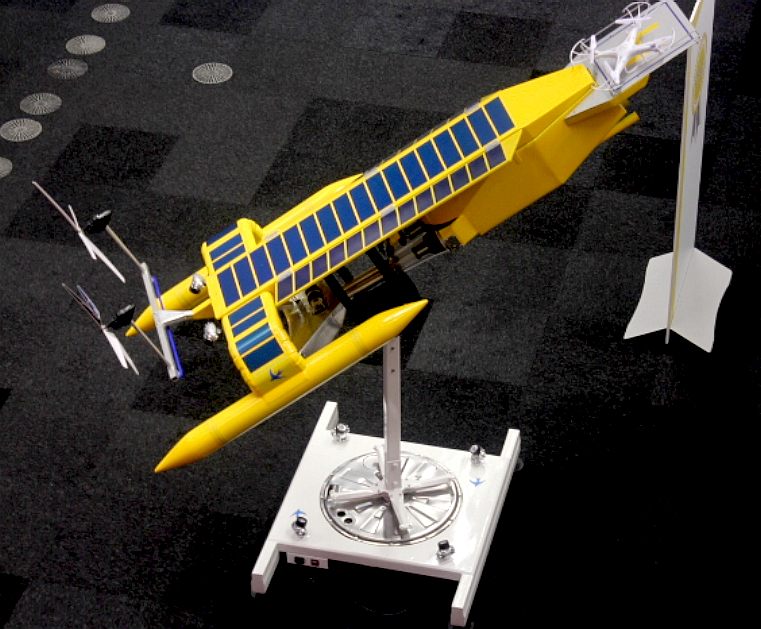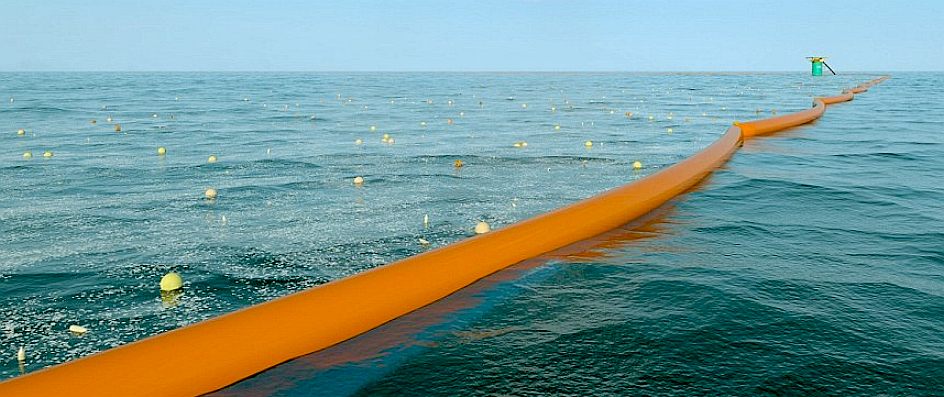|
THE
TERRAMAR PROJECT 22 FEBRUARY 2016

RIVERVAX™
- Is a potential solution for surface (and subsurface) river
and ocean pollution that is cost effective.
The value of such a versatile vessel might not be limited to the ability
to vacuum the Ganges
clean for example, but the blue water version, called SeaVax,
could target any area of the high seas that is rich enough in
plastic waste to make it worthwhile for the operators. This go
anywhere workboat is solar and wind
powered, another step forward for any nation that is doing their
level best to combat climate
change and acid oceans. The
vessel is designed to hold 150 tons of waste until it can
discharge at sea to a transfer tanker, or dock in port and
discharge directly to waiting treatment plants.
PROTOTYPE
FOR ROBOTIC BOAT TO SUCK UP PLASTIC WASTE UNVEILED AT INNOVATE
UK
With more plastic than fish expected in our oceans by 2050, cleaning up this mess seems like an impossible task. But a team of inventors from Sussex, England have developed a novel solution. The SeaVax is a solar- and wind-powered ship that can suck up plastic waste.
The inventors at Bluebird Marine Systems LTD unveiled their proof of concept at the government-funded Innovate UK show in London in November. The inventors are entering prototype phase, the Express reported.
The ship purportedly works by funneling plastic waste as it moves forward. According to this mockup posted to the Innovate UK website, once built, the vessel will be around 144 feet long and fully autonomous. Deck-mounted solar panels and two wind turbines will feed power to electric pumps and filters that can suck up plastic solids and micro plastics. An onboard shredder rips and breaks up larger pieces of debris.
The builders calculated on their website that the finished robovac will be able to generate enough energy to treat an average of 89.9 million liters of seawater in a year, translating to 22,400,000 kilograms of plastic from a body of water that has high concentrations of surface solid plastic, such as river estuaries.
“Working in a fleet, these autonomous robotic boats could keep plastic buildup contained and significantly reduce the existing ocean gyres in around 5-10 years, cost effectively,” the inventors said.
More information: www.bluebird-electric.net
THE
OCEAN
CLEANUP PROJECT
SeaVax
is relatively fresh to the scene, but Dutch inventor Boyan
Slat, 21, has been working on setting giant floating traps for
fishermen and other commercial shipping since 2014. His not
for profit organisation is planning to float large booms
across targeted sections of the ocean, that are anchored
to the ocean floor.
His
team of almost 100 experts claim that plastic waste will be
concentrated by the booms set in a 'V' formation, as the ocean
currents drift by. The concentrated plastic soup will then be
collected by a ship about once a month.
Everyone
seems to agree that to make life easier for downstream
cleaners, that governments should do what they can upstream to
stop plastic getting into our rivers and onto our beaches, and
then into the oceans, by clamping
down on single use plastic sales and manufacturing. Better recycling is a must
as is asking the public to act responsibly. You only have to
ask and most people will respond favorably.

OPEN
WATER HAZARD - Boyan Slat's company estimates that a 62-mile stationary cleanup array could remove 42 per cent of the Great Pacific Garbage Patch over 10 years, representing a total of 70,320,000kg of plastic waste.
Undeniably such booms present a potential
danger to marine traffic, unless good warning is given both
visually and digitally on maps. You can just imagine the
entanglements that could arise, physical and legal. Could
though, tankers and cargo ships simply steam over the flexible
barrier without damaging it or themselves- the propellers
being the only real danger. It is 50/50 whether the bulbous
nose of most large ships will go over or under the booms. If
the nose goes over, great. In the nose goes under - disaster
for the boom anchoring.
Skeptics
abound with good reason. When we asked Bluebird Marine Systems
what they thought, they said:
"They've
come a long way and the idea may not work, but Boyan should
let the dice roll and continue with the experiment. If the
boom proves to be dangerous to marine life and/or shipping,
then the plug should be pulled. Then again it may work and
simply need development - but it is worth the efforts of his
team to see what the outcome is. It might be an idea to give
independent experts access to the data and the booms in
transparent fashion."
"We
will be working with marine biologists to fine tune our SeaVax
so as not to harm micro organisms. If our prototype is sucking
up plankton (etc) we'd need to know under what circumstances
that is happening so the we can program the computers to know
not to allow that. We will learn by doing and correct mistakes
on the first boat, so that when a fleet is sent out to sea,
each production model will benefit from a series of practical
trials, deliberately designed to test the operating parameters
to achieve an ocean friendly vessel."
ABOUT
THE TERRAMAR PROJECT
The TerraMar Project
(TP) is a nonprofit ocean organization dedicated to building a global community
around their love of the ocean and the need to protect and conserve the seas.
They aim to use the collective strength of their global community to be the
clarion call for change on how world leaders manage the oceans and the
life within.
They would like to build on success at the United Nations creating an ocean-specific Sustainable Development Goal,
now re-focusing their efforts to combat plastic pollution in the ocean.
WHY THE OCEAN - The ocean feeds billions of people, provides over half our oxygen, and
controls the planet's weather – but the ocean is in trouble.
THE PROBLEMS - Over-fishing, marine pollution, ocean
warming, ocean acidification, unsustainable development and one of the most preventable is plastic pollution - which is why TerraMar
say that they will focus on this area.
With 8 million metric tons of plastic entering the ocean each year, and that amount
predicted to double to about 17.5 million metric tons by 2025,
this is a serious problem. Scientists also predict there will be more plastic than fish in the ocean by
2050.
PLASTIC IS FOR KEEPS - Every piece ever produced can still be found somewhere in the world. When it reaches the ocean, it breaks down into smaller and smaller pieces. Not only is it impossible to clean at this point, but millions of fish and
birds mistake these microplastics for food. An example of the waste: we use and discard more than a trillion plastic bags a year, and nearly every bag winds up in a landfill or in the ocean.
WHAT IS THE SOLUTION - The TerraMar Project is working with partners all over the world to prevent plastic entering the ocean by raising awareness about the risks of plastic pollution whilst educating on the impact of plastic waste and the alternatives to plastic use.
WHAT THEY SUPPORT -
* A global, engaged, and informed community of ocean lovers.
* Innovative, legislative, technological and common sense measures to reduce the amount of plastic polluting our ocean to drive a sharp reduction in marine debris, which includes the tracking and regulation of discarded fishing gear.
* Measures by the international community to meet and exceed the targets set forth in the United Nations Sustainable Development Goal 14: Conserve and sustainably use the oceans, seas and marine resources for sustainable development.
* Sustainable fishing practices throughout global fisheries.
* Additional, expanded, and effectively enforced Marine Protected Areas – areas of great importance to biodiversity that are off limits to extractive activities such as fishing and mining.
* An effective system to track and monitor illegal, unregulated, and unreported
fishing vessels.
* Extensive ocean science and research – less than 5% of the ocean has been explored.
* Clean energy solutions and science-based methods to fight ocean acidification and warming.
THE TERRAMAR TEAM
Ghislaine MAXWELL, Founder and President
Ghislaine Maxwell has a lifelong love and appreciation for the ocean. She is a successful businesswoman, holds a BA-MA from Oxford University, and is a helicopter, and deep worker submersible pilot and a certified EMT.
Rob Foos, Director of Development
Rob Foos holds a BS in Management from the U.S. Coast Guard Academy. He was a collegiate rugby player, winning a national championship. He commanded a ship, served on three regional fishery management councils, and led fundraising efforts across the federal government in south Florida. Growing up on the water in California, he loves exploring everything ocean related and is looking forward to his next adventure on the high seas.
Inge Solheim, Polar Ambassador
Inge Solheim is the world’s foremost polar guide and explorer. He led Prince Harry and injured soldiers on expeditions to the North and South Poles. Inge has also produced and co-produced many television series featuring some of the world's most remote areas, witnessing firsthand the decline of the polar regions. A native Norwegian, he’s joining TerraMar to save the poles by bringing attention to the least explored part of the
planet - the ocean.
THE TERRAMAR BOARD
Steven Haft
Steven Haft serves as Advisor at LiveLOOK, Inc. and serves as Chair of Allscreen Studios at Burson-Marsteller, LLC. As a producer, his productions have garnered 7 Oscar Nominations, 8 Emmy Nominations and a Peabody Award. He has served as Chief Strategy Officer of the interactive marketing group at AOL. He has a 15-year career in Politics, Law and Public Policy.
Amir Dossal
Amir Dossal is a 25-year veteran of the United Nations, and was the UN’s Chief Liaison for Partnerships. As Executive Director of the UN Office for Partnerships, he managed the $1 billion gift by media mogul Ted Turner; and forged strategic alliances to address the Millennium Development Goals.
CORPORATE MAKE UP - CHARITABLE STATUS
CLIVE, Lucy Mary (Art Director)
Director since 22 August 2013 - British UK resident
MAXWELL, Ghislaine Noelle Marion (Business Consultant)
Director since 22 August 2013 - British US resident
VAUGHAN-EDWARDS, Catherine Mary Emma (Personal Assistant)
Director since 22 August 2013 - British UK resident
CONTACTS
TERRAMAR (UK)
Registered office
Orchard End, Fittleton
Salisbury, Wiltshire
SP4 9QA
Company No: 08661523 A Private Limited Company by guarantee without share capital.
Nature of business: 99000 - Activities of extraterritorial organisations and bodies
LINKS
& REFERENCE
The
Terramar Project daily catch prototype for robotic boat suck
plastic waste unveiled innovate uk
https://ecowatch.com/2016/02/19/seavax-vacuum-ocean-plastic/
http://theterramarproject.org/thedailycatch/prototype-for-robotic-boat-suck-plastic-waste-unveiled-innovate-uk/
5gyres
blog posts 2016
gyres_in_india_contrasts_of_rich_and_poor_where_does_the_plastic_pollution_go
http://www.globalspec.com/
Outside
Online ocean doubt
DailyMail
UK news 20 year old inventors plan clean ocean five years
practise Japan year
https://www.youtube.com/watch?v=ZD8l94tq46k
http://theterramarproject.org/thedailycatch/prototype-for-robotic-boat-suck-plastic-waste-unveiled-innovate-uk/
http://www.dailymail.co.uk/home/search.html?s=&authornamef=Becky+Pemberton+For+Mailonline
http://www.dailymail.co.uk/home/search.html?s=&authornamef=Fiona+Macrae+for+the+Daily+Mail
http://www.dailymail.co.uk/travel/travel_news/article-3112298/20-year-old-inventor-s-plan-clean-ocean-five-years-practise-Japan-year.html
http://www.outsideonline.com/1999216/ocean-doubt
https://www.youtube.com/user/TheOceanCleanup
https://scripps.ucsd.edu/
www.bluebird-electric.net
http://www.oceanconservancy.org/
http://www.theoceancleanup.com/
http://insights.globalspec.com/article/2132/cleanup-systems-aim-to-stem-the-tide-of-ocean-plastic-pollution
http://www.globalspec.com/
http://www.5gyres.org/blog/posts/2014/04/17/5_gyres_in_india_contrasts_of_rich_and_poor_where_does_the_plastic_pollution_go
http://www.bluebird-electric.net/oceanography/Ocean_Plastic_International_Rescue/SeaVax_Ocean_Clean_Up_Robot_Drone_Ship_Sea_Vacuum.htm
http://theterramarproject.org/thedailycatch/prototype-for-robotic-boat-suck-plastic-waste-unveiled-innovate-uk/
https://ecowatch.com/2016/02/19/seavax-vacuum-ocean-plastic/
http://www.energymatters.com.au/renewable-news/solar-wind-seavax-em5350/
http://www.csiro.au/en/News/News-releases/2015/Marine-debris
http://www.express.co.uk/search/Maisha+Frost%252C+Exclusive?s=Maisha+Frost%2C+Exclusive&b=1
http://www.express.co.uk/finance/city/638166/New-cleaner-SeaVax-has-solution-to-ocean-plastic-waste
|
